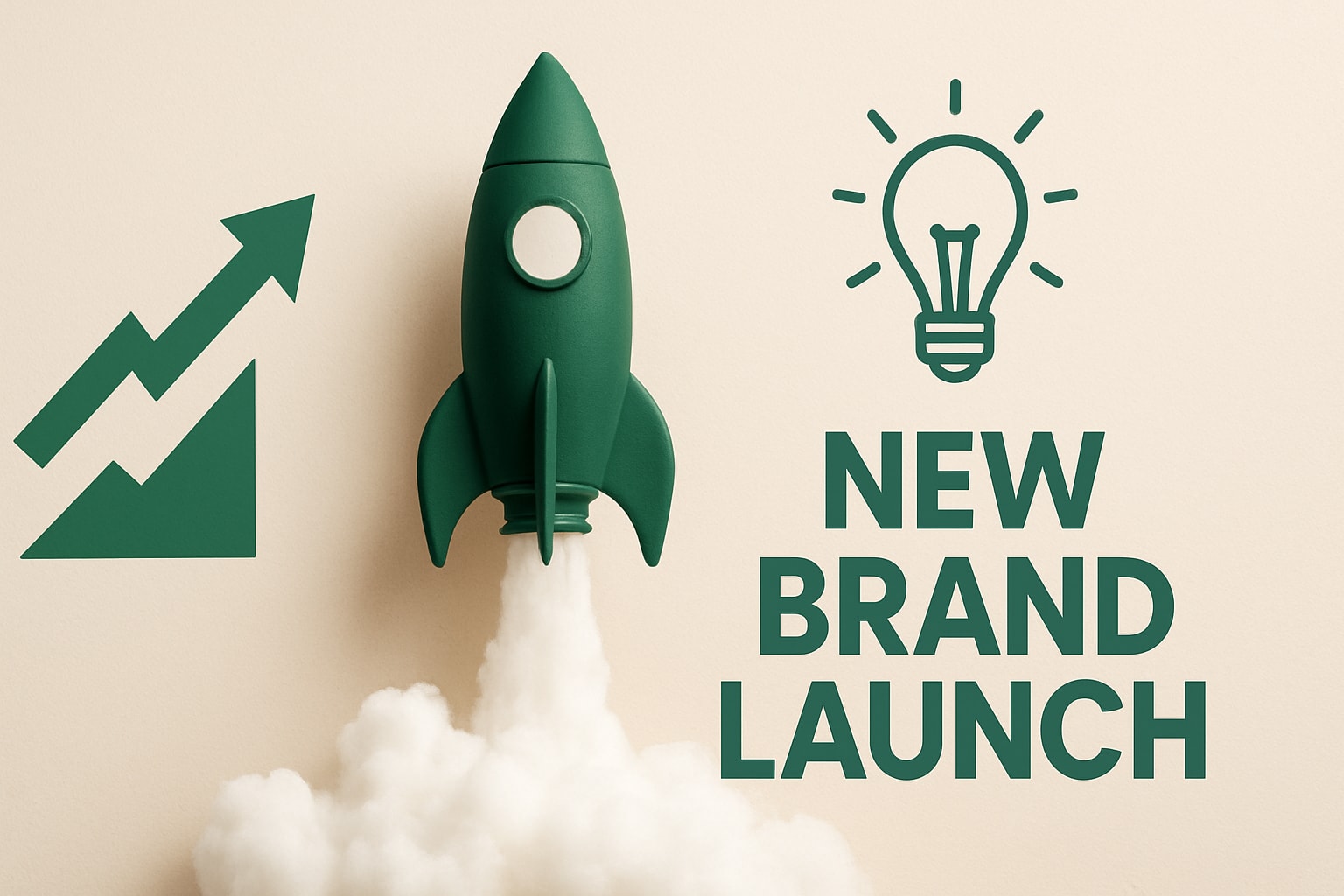
8 Inspiring New Brand Launch Ideas to Try in 2025
In 2025, launching a successful brand means facing intense competition and rapidly evolving consumer expectations. Gone are the days when a basic announcement or press release could guarantee attention. To stand out, a new brand launch requires creativity, innovation, and a memorable approach.
This article unlocks eight inspiring new brand launch ideas designed to spark buzz, fuel engagement, and foster lasting customer loyalty. If you want your next launch to be both impactful and unforgettable, read on for a strategic roadmap to success.
The Evolving Landscape of Brand Launches in 2025
The landscape for every new brand launch is rapidly transforming in 2025. Brands must now navigate a market defined by changing consumer habits, emerging technologies, and fierce competition. To stand out, it is essential to understand how launch strategies are evolving and what it takes to achieve lasting impact.

The Shift from Traditional to Experiential Launches
Today’s consumers expect more than basic product reveals or press releases. They crave immersive, interactive experiences that create memorable moments. Recent research reveals that 73% of launches underperform when brands rely solely on outdated, one-off tactics. This signals a clear shift in the approach to a new brand launch.
Digital-first and hybrid launch models have surged in popularity since the pandemic. These models blend online engagement with in-person elements, reaching wider audiences while maintaining excitement. Brands like TikTok and Square have excelled by building systems that extend the launch journey across multiple channels, rather than focusing on a single event. This systematic approach ensures each new brand launch remains top-of-mind and drives sustained engagement.
Key Trends Shaping New Brand Launches
Several emerging trends are redefining the standards for a successful new brand launch:
Personalization and emotional connection are now critical differentiators.
AI and automation allow brands to scale content and tailor experiences.
Micro-communities and niche audiences are increasingly influential.
Authenticity and transparency in messaging are in high demand.
Storytelling, social proof, and user-generated content boost credibility.
Trust is a major factor for consumers when considering a new brand launch. According to Branding Statistics 2025, 81% of buyers need to trust a brand before making a purchase. This makes authenticity and social proof essential components of any forward-thinking launch strategy.
Challenges Brands Face in 2025
Despite the opportunities, brands encounter significant challenges during a new brand launch:
Oversaturation of digital channels leads to content fatigue.
Sustaining momentum beyond the initial buzz can be difficult.
Balancing speed-to-market with strategic clarity is crucial.
Privacy concerns complicate data-driven personalization efforts.
Coordinating multi-platform campaigns adds operational complexity.
To succeed, brands must find ways to overcome these obstacles. A resilient new brand launch strategy requires flexibility, ongoing innovation, and a clear understanding of the evolving landscape.
8 Inspiring New Brand Launch Ideas to Try in 2025
Launching a new brand in 2025 demands creativity, agility, and a deep understanding of what truly engages modern consumers. The following eight ideas offer actionable strategies for building visibility, excitement, and loyalty from the very first touchpoint. Each approach is tailored to help your new brand launch break through the noise and create lasting impact.

1. Teaser Campaigns with Interactive Elements
The first stage of a successful new brand launch in 2025 is building anticipation. Teaser campaigns with interactive features captivate audiences and generate buzz before the main reveal.
Start by crafting a multi-phase campaign using mystery, gamification, or AR filters. Consider cryptic social media posts, countdown timers, or unlockable content to spark curiosity. For example, a beauty brand could use Instagram Stories polls to gradually unveil product features, inviting followers to participate in the discovery.
Short-form video teasers work exceptionally well, offering rapid engagement across platforms like TikTok and Instagram Reels. Pair these with interactive landing pages that collect early sign-ups and feedback, laying the foundation for a robust launch database.
According to competitor data, brands leveraging teaser campaigns see up to 3x higher pre-launch engagement. To ensure your new brand launch aligns with your overall messaging, focus on visuals and copy that reinforce your core values and voice.
Tips for success:
Use a consistent hashtag and visual theme.
Offer incentives for early participation.
Test different interactive elements to see what resonates.
By making your new brand launch an experience from the outset, you prime your audience for excitement and buy-in.
2. Story-Driven Brand Narratives
A compelling brand narrative is the backbone of any memorable new brand launch. Consumers crave authenticity, and storytelling bridges the gap between product features and emotional connection.
Begin by defining what makes your brand unique. Use founder-led videos, behind-the-scenes content, or customer testimonials to humanize your story. For example, Square successfully adapted its narrative for different international markets, resulting in a 40% boost in engagement.
Ensure your story is consistent across all channels by developing a scalable voice system. Frameworks for social, email, and web help maintain coherence and build trust. Data shows that systematic storytelling increases both brand recall and loyalty.
Actionable steps:
Map out your brand’s origin, mission, and vision.
Create a content calendar featuring story elements.
Repurpose narrative assets for each platform.
For expert guidance on the difference between brand and founder storytelling, explore Crafting your brand storytelling.
A new brand launch rooted in authentic storytelling is more likely to foster lasting relationships and set your brand apart.
3. Social Media Blitz Launches
Executing a social media blitz is a powerful way to maximize visibility during a new brand launch. This approach involves coordinating a concentrated burst of content across all major platforms within a short time frame.
Repurpose creative assets into multiple formats, such as reels, carousels, and live streams. DTC brands often use limited-time launch hashtags to generate urgency and excitement, encouraging rapid sharing and participation.
Influencer takeovers and user-generated content (UGC) are invaluable, as they amplify reach and provide authentic endorsements. According to industry data, integrated social blitzes can generate up to 10x more impressions than staggered campaigns.
To sustain momentum after the initial wave:
Schedule follow-up posts highlighting user reactions.
Share behind-the-scenes content from launch day.
Run giveaways or challenges linked to your launch hashtag.
A well-planned social blitz ensures your new brand launch remains top-of-mind and drives measurable engagement across platforms.
4. Influencer and Micro-Community Collaborations
Partnering with influencers and micro-communities is essential for a targeted new brand launch in 2025. Audiences trust recommendations from niche leaders, making these collaborations especially effective.
Start by identifying influencers whose values align with your brand. Co-create content, events, or challenges tailored to specific audience segments. Tech startups, for instance, often leverage Discord or Slack communities for early product feedback and advocacy.
Micro-influencer campaigns tend to yield higher engagement rates than those with macro-influencers, as the connection is more personal and credible. Strategies for success include:
Vetting potential partners for authenticity and relevance.
Setting clear expectations for deliverables and metrics.
Building long-term relationships beyond the initial launch.
Measuring ROI is crucial. Track metrics such as engagement, referral traffic, and conversion rates to assess the impact of your new brand launch collaborations.
By tapping into micro-communities, you ensure your new brand launch resonates deeply with those most likely to champion your brand.
5. Immersive Virtual or Hybrid Launch Events
Modern consumers expect more than a simple announcement. Immersive virtual or hybrid events transform a new brand launch into a memorable experience.
Host interactive online events featuring live demos, Q&A sessions, and networking rooms. Combine these with in-person pop-ups or VR showrooms for broader appeal. Fashion brands, for example, have found success with live shopping streams and virtual fitting rooms.
Hybrid events are proven to increase attendance and engagement by up to 60%. To maximize impact, include features like real-time polls, exclusive giveaways, and behind-the-scenes content.
Planning tips:
Develop a detailed timeline for pre-event promotion and post-event follow-up.
Select a reliable tech stack for seamless streaming and interaction.
Collect attendee feedback to refine future events.
After the event, keep the buzz alive by sharing highlight reels and exclusive content with your new brand launch audience.
6. User-Generated Content (UGC) Launch Challenges
Encouraging user-generated content is a dynamic way to involve your audience in your new brand launch. Branded hashtag challenges and contests turn customers into co-creators, fostering trust and excitement.
Launch a campaign inviting users to share their stories, reviews, or creative photos. Fitness brands, for instance, often run transformation photo contests on TikTok, driving engagement and authenticity.
UGC campaigns deliver results: they can double trust and conversion rates compared to branded content alone. To maximize participation:
Offer meaningful incentives, such as prizes or feature opportunities.
Provide clear guidelines for submissions.
Curate and showcase the best entries across your channels.
Integrate UGC into ongoing marketing efforts and product development. Remember to manage legal rights and permissions to protect both your brand and contributors.
By making your audience part of the story, your new brand launch becomes a shared experience that extends beyond the initial reveal.
7. Purpose-Driven and Social Impact Launches
Aligning your new brand launch with a cause or social initiative can set you apart in a crowded market. Today’s consumers are increasingly values-driven and seek brands that stand for something meaningful.
Consider donating a portion of launch sales or partnering with nonprofits to amplify impact. CPG brands, for example, may introduce eco-friendly packaging alongside a sustainability pledge.
Data reveals that 63% of consumers prefer brands with a clear purpose. To communicate your impact authentically:
Share transparent stories about your mission and outcomes.
Highlight partnerships and real-world results.
Build long-term advocacy through ongoing updates.
Measuring social impact ROI involves tracking both quantitative and qualitative metrics, such as funds raised, volunteer hours, and sentiment analysis.
A purpose-driven new brand launch not only attracts attention but also builds lasting loyalty and advocacy.
8. AI-Powered Personalization and Launch Automation
AI is revolutionizing the way brands approach personalization and automation in every new brand launch. By leveraging AI tools, you can deliver tailored messages, offers, and experiences at scale.
Segment your audience for targeted email campaigns, dynamic web content, and chatbot support. SaaS brands, for example, use AI to recommend personalized launch bundles based on user behavior.
Personalized campaigns can boost open rates by over 50%. To integrate AI effectively:
Map automation workflows for follow-up, nurture, and feedback.
Balance technology with human touch to maintain authenticity.
Monitor performance data to refine your approach.
According to recent statistics, 73% of marketers now regularly use AI tools in their campaigns, highlighting the growing importance of this strategy for any new brand launch.
AI-powered personalization not only improves efficiency but also deepens customer relationships from day one.
Building a Consistent Brand Voice for Launch Success
Establishing a clear brand voice is a non-negotiable foundation for any new brand launch. In 2025, the crowded digital landscape makes it easy for even the most innovative ideas to get lost without a unified message. Consistency is what transforms fleeting attention into lasting brand loyalty.

The Role of Messaging in Memorable Launches
A successful new brand launch depends heavily on the clarity and emotional intelligence of your messaging. When your launch hits the spotlight, a consistent brand voice is the anchor that keeps your identity stable, even as you adapt to different platforms and audiences.
Brands that scale quickly often do so by prioritizing message clarity. For example, companies launching in multiple markets build memorability by ensuring every touchpoint speaks the same language, both visually and verbally.
The risks of inconsistent or generic messaging during a new brand launch are significant:
Loss of audience trust and confusion
Diluted brand recall
Missed opportunities for emotional connection
To integrate brand building with measurable results, consider balancing brand building and performance for a holistic launch strategy. Ultimately, your voice should be as recognizable as your logo, shaping every campaign and customer interaction.
Steps to Develop a Cohesive Brand Narrative
Before your new brand launch, a structured approach to developing your narrative will set you apart. Start with a brand voice audit, ensuring your team's understanding matches your vision. Map your core values and vision into messaging frameworks that can scale across channels.
Follow these actionable steps:
Conduct a brand voice audit to identify strengths and inconsistencies.
Define your brand’s core values, vision, and proof points for messaging.
Create a voice and tone guide that everyone can reference.
Train your team and partners for consistent message delivery.
Deploy your narrative across social, web, email, and live events.
Founder-led brands often excel by unifying launch assets with a clear voice system.
Tools and Resources for Brand Messaging
Equipping your team with the right tools ensures your new brand launch message remains consistent and impactful. Templates for brand story, positioning, and launch messaging provide a strong starting point. Collaborative platforms, like shared docs or project management tools, streamline feedback and revisions.
Consider this simple checklist before launch:
Is your brand story documented and accessible?
Do you have a voice and tone guide for all launch content?
Has your messaging been reviewed by all stakeholders?
Are feedback channels open for real-time adjustments?
A consistent brand voice is not just a creative asset, but a strategic advantage for any new brand launch.
Measuring and Sustaining Launch Momentum
Launching a new brand launch is only the beginning. The real challenge lies in measuring success and keeping momentum alive long after the initial excitement fades. To transform a new brand launch into lasting growth, marketers must focus on clear metrics, intentional engagement strategies, and a commitment to continuous improvement.

Key Metrics to Track Launch Performance
To assess a new brand launch, brands must track metrics that reflect both buzz and business impact. Engagement rates such as social shares, comments, and user-generated content submissions offer insight into how well your messaging resonates. Conversion metrics, including sign-ups, sales, and referral rates, directly measure the effectiveness of your call to action.
Sentiment analysis tools help gauge public perception and brand recall, while event attendance and post-event actions indicate audience commitment. According to Consumer Discovery via Ads, 83% of consumers discover new brands through advertising, so monitoring ad performance is critical for any new brand launch. Combine these data points to create a holistic view of your launch success and identify opportunities for optimization.
Strategies for Post-Launch Engagement
Sustaining interest after a new brand launch requires more than a single campaign. Begin by nurturing new customers through onboarding sequences that provide value and reinforce your brand promise. Gathering feedback and testimonials not only builds social proof but also helps shape future marketing efforts.
Consider launching referral or loyalty programs to extend buzz and encourage repeat engagement. Use real-time data to iterate campaigns, refine messaging, and introduce new touchpoints as your audience evolves. Segment customers based on their launch interactions to tailor ongoing communication and offers, ensuring your new brand launch remains top of mind.
Examples of Sustained Launch Success
Some brands excel at turning a new brand launch into long-term growth. Those who prioritize consistent customer engagement, transparent communication, and data-driven iteration often outperform competitors. For instance, companies that analyze post-launch performance and swiftly act on feedback are more likely to retain momentum.
On the other hand, launches that rely solely on initial hype tend to fizzle out quickly. Learning from these outcomes, create an action plan that includes regular performance reviews, audience listening, and content refreshes. For deeper insights on overcoming common obstacles after a new brand launch, explore Overcoming personal brand challenges. With a disciplined approach, your new brand launch can evolve into a powerful engine for ongoing brand growth.
Ashley Kedra
Kedra&Co


